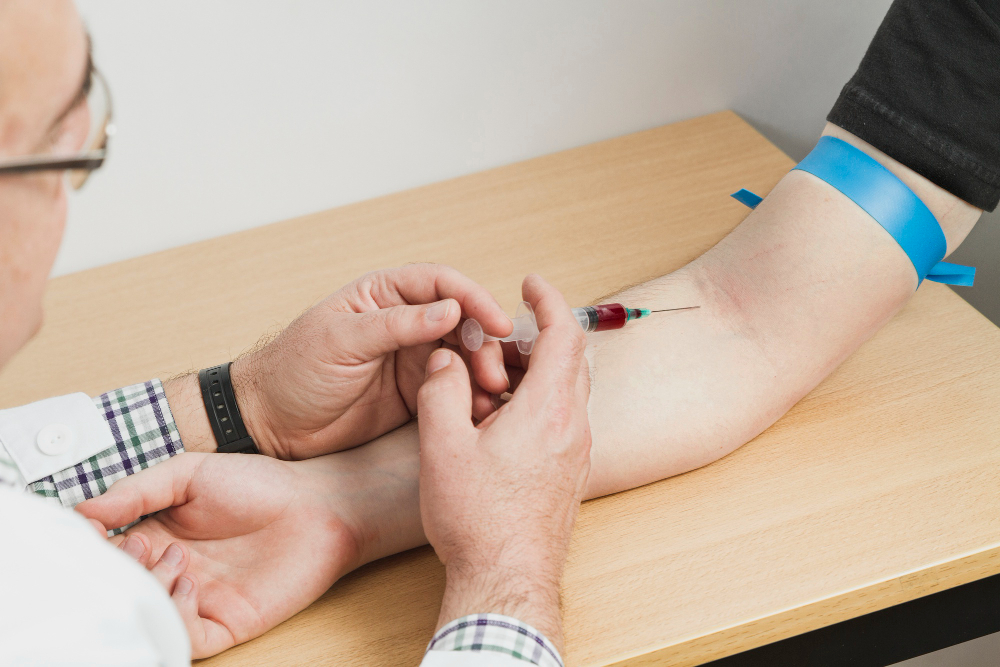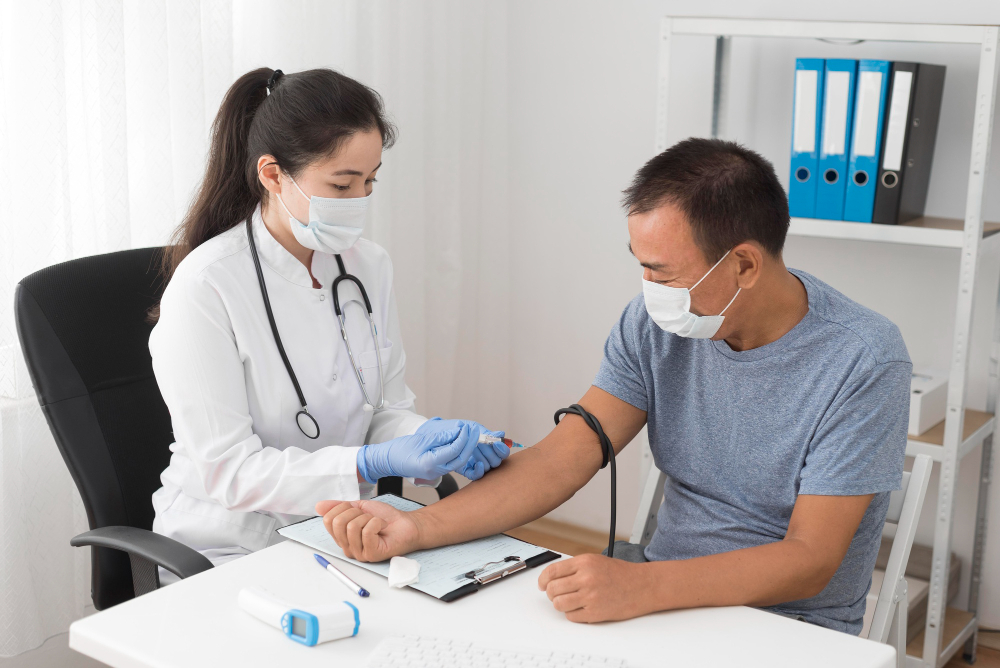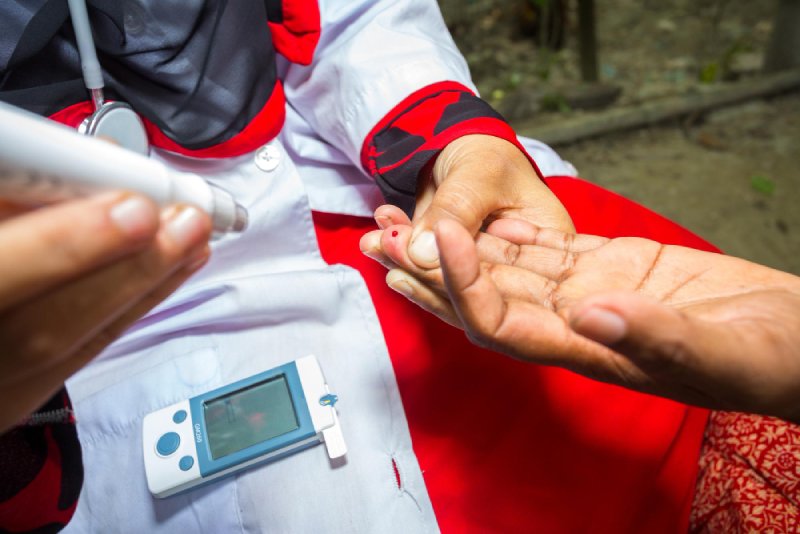Book on Whatsapp
9892101616
SGPT and SGOT Test Normal Range Levels and What They Indicate
Blood Test
Fri Jan 24 2025
The article will discuss the evaluation of liver function, blood tests called SGPT (Serum Glutamate Pyruvate Transaminase) and SGOT, which (Serum Glutamate Oxaloacetate Transaminase) are mainly performed.
The article will also discuss the liver's primary place for these enzymes, which are also found in the heart, muscle tissue, and kidneys. They are also referred to as ALT (alanine synthetase) and AST (aspartate synthetase), respectively. It is a very crucial test for the identification of liver damage, tracking the development of liver disease, and assessing how well treatments are performed.
SGPT (ALT) and SGOT (AST) Indicate
The enzymes SGPT and SGOT both play a role in the body's amino acid conversion. They play a role in the metabolism of proteins and energy. However, the amount of these enzymes is higher in the liver. The release of SGPT and SGOT in the circulation as a result of inflammation or damage to the liver cells causes elevated levels. Therefore, keeping an eye on these enzyme levels provides valuable insight into liver health.
While SGPT is more specific to the liver, SGOT is found in a variety of tissues, including the heart, muscles, and the liver organ. Therefore, while elevated SGOT values may indicate liver issues, they may also indicate abnormalities in the heart or muscles.
Normal Range Levels
The typical ranges of references for the SGPT and SGOT can differ slightly based on age, gender, the laboratory, and other variables. Nonetheless, the following general rules apply to normal enzyme levels:
- The normal range for SGPT (ALT) is 7 to 56 units per litre (U/L) of blood.
- Values outside of this range could be a sign of inflammation or liver damage.
- The normal range for SGOT (AST) is 10 to 40 units per litre (U/L) of blood.
As a result, it is crucial to consider additional tests along with clinical findings when interpreting these test results.
What Elevated SGPT and SGOT Levels May Indicate
1. Liver Disease:
- Hepatitis, which can cause inflammation of the liver, is one viral infection that can cause an increase in SGPT and SGOT.
- Fatty Liver Disease (NAFLD): Individuals with a condition called fatty liver, which can be brought on by weight gain, diabetes, and alcohol use, frequently have elevated SGPT levels.
- Cirrhosis: This condition causes the liver to become scarred and unable to function normally, which raises the levels of SGPT and SGOT.
2. Alcoholic Liver Disease:
- Increased SGPT method and SGOT levels are a symptoms of an alcoholic liver disorder, which is brought on by prolonged alcohol use. In alcoholic liver disease, SGOT is frequently disproportionately greater than SGPT.
Interpreting Test Results
When excessive SGPT and SGOT levels are discovered, medical care frequently suggests further testing to identify the underlying cause. It also includes liver function tests, imaging examinations (CT scan, ultrasound), and tests for certain infections like hepatitis. It will determine the underlying enzymes. The modification of lifestyle avoiding alcohol, lowering weight, or controlling underlying medical issues like diabetes may be adequate for people with slightly increased SGPT and SGOT levels. Medical intervention may be necessary to treat the underlying illness in cases of serious liver damage.
Conclusion
Tests like SGPT and SGOT are essential for evaluating liver health and identifying possible liver, heart, and muscle problems. Additionally, it was determined that while elevated levels may suggest liver inflammation or injury, normal levels of these enzymes aid in ensuring the liver functions properly. To address any underlying issues and stop more liver damage, early detection and action are essential. To ensure prompt diagnosis and treatment, it is crucial to see a healthcare professional and have these tests performed if someone exhibits symptoms like exhaustion, jaundice, or unexplained pain.
Related Tests
Related Packages
Related Blogs

Blood Test
HbA1c Blood Test for Long-Term Diabetes Control
Managing diabetes is not just about keeping track of daily blood sugar readings it is about maintaining long-term stability. One of the most trusted tools for this purpose is the HbA1c blood test, often referred to as the “three-month average test”. it reveals how well your blood sugar has been managed over the past 8 to 12 weeks. For anyone living with diabetes, this test plays a vital role in monitoring health and preventing future complications.
What is the HbA1c Test?
Hemoglobin A1c (HbA1c) is a simple blood test that measures the percentage of hemoglobin, the protein in red blood cells that carries oxygen, coated with sugar (glucose). When glucose circulates in your blood, it naturally attaches to hemoglobin. The higher your blood sugar levels, the more glucose sticks to the hemoglobin. Since red blood cells live for about three months, the HbA1c test gives an average picture of your blood sugar levels over that period, unlike daily finger-prick tests, which show only current levels.
Why is it Important?
The HbA1c test is essential for both diagnosing diabetes and monitoring its control.
- A normal HbA1c level is usually below 5.7%.
- Levels between 5.7% and 6.4% may indicate prediabetes,
- Levels of 6.5% or higher suggest diabetes.
For people already diagnosed, doctors often recommend keeping HbA1c below 7% to reduce the risk of complications.
Unlike random blood sugar checks that fluctuate depending on meals, stress, or activity, HbA1c provides a clearer and more reliable picture of overall control. This helps doctors adjust medications, lifestyle plans, and treatment strategies more effectively.
Benefits of the HbA1c Test
- Long-Term Insight – Instead of worrying about one or two high readings, the HbA1c test shows your overall pattern.
- Convenient – No fasting is required. You can take this test at any time of the day.
- Early Warning System – Consistently high HbA1c levels warn of poor control, which could lead to complications such as kidney damage, heart disease, eye problems, or nerve issues.
- Motivation for Lifestyle Changes – Seeing your HbA1c improve can be highly motivating, encouraging healthier food choices, regular exercise, and proper medication use.
How Often Should You Take the Test?
For people with diabetes, doctors usually recommend taking the HbA1c test at least twice a year. However, if treatment is being adjusted or blood sugar levels are unstable, the test may be advised every three months. For individuals at risk of diabetes, routine testing can help detect the condition early and prevent it from progressing.
Improving Your HbA1c Levels
Lowering HbA1c is possible with consistent effort. Here are some effective strategies:
- Balanced Diet – Include more whole grains, vegetables, lean proteins, and fiber-rich foods while limiting refined sugars and processed snacks.
- Regular Exercise – Aim for at least 30 minutes of physical activity most days of the week.
- Medication Adherence – Take diabetes medicines or insulin as prescribed by your doctor.
- Stress Management – Stress can raise blood sugar, so relaxation techniques such as yoga, meditation, or deep breathing can help.
- Regular Monitoring – Combine home blood sugar checks with HbA1c testing to stay on track.
The HbA1c test is more than just a number; it serves as a health compass that guides people living with diabetes toward long-term control and better quality of life. By offering a reliable picture of how well blood sugar has been managed over months, it empowers individuals and doctors to take timely action. Regular HbA1c testing, along with a healthy lifestyle and proper treatment, is the key to reducing complications and living well with diabetes.
At Manipal TRUtest, we offer comprehensive diabetes testing packages, including HbA1c test, to help you stay on top of your health. Early monitoring leads to better outcomes—schedule your test today.

Blood Test
Know the Reason Behind Your Fever with a Blood Test
Fever is one of the most common symptoms experienced by people of all ages. It is not a disease but a warning sign that the body is fighting an infection or responding to an underlying health issue. While occasional, mild fevers often resolve on their own, persistent or high-grade fever should never be ignored. Understanding the root cause of fever is crucial , and this is where a blood test plays a vital role.
Why Fever Occurs
Fever occurs when the body’s temperature rises above the normal range, usually in response to an infection. This rise in temperature is the immune system’s way of creating an environment less favourable for bacteria or viruses to survive. Common causes of fever include –
- viral infections (such as flu or dengue),
- bacterial infections (such as typhoid or urinary tract infections),
- parasitic diseases (such as malaria), and
- inflammatory or autoimmune conditions.
- side effects of medication or a sign of more serious illnesses.
The Role of Blood Tests in Identifying the Cause
When a fever lasts more than a couple of days, or when its origin is unclear, a blood test becomes an important diagnostic tool. It helps doctors pinpoint the underlying cause, differentiate between bacterial and viral infections, and assess the severity of the illness.
Some common blood tests for fever diagnosis include:
- Complete Blood Count (CBC) – Evaluates the levels of red and white blood cells, helping detect infections, anaemia, or blood disorders.
- Blood Culture – Identifies bacteria or fungi in the blood, guiding doctors in selecting the right antibiotics.
- Malaria Parasite Test – Detects the presence of malaria-causing parasites.
- Dengue NS1 Antigen and Antibody Tests – Confirms dengue fever and determines its stage.
- Typhoid Tests (Widal or TyphiDot) – Diagnose typhoid fever caused by Salmonella bacteria.
- ESR and CRP Tests – Measure inflammation levels in the body, useful for detecting infections or autoimmune conditions.
Benefits of Early Diagnosis
Timely blood testing not only helps confirm the cause of fever but also ensures that the right treatment is started without delay. This prevents complications, reduces the duration of illness, and avoids unnecessary use of antibiotics in cases where they are not required. For example, if a blood test confirms a viral infection, supportive care may be sufficient; but if it points to a bacterial infection, the correct antibiotics can be prescribed immediately.
When to Seek Medical Help
You should consult a doctor and consider a blood test if your fever is high-grade (above 102°F), lasts for more than 3 days, is accompanied by severe symptoms like rash, persistent vomiting, breathing difficulties, chest pain, confusion, or if it occurs in infants, elderly individuals, or people with weakened immunity.
A fever should never be dismissed as “just a common symptom.” It is your body’s way of asking for attention. Blood tests are the most reliable way to uncover the real cause, enabling your doctor to provide the most effective treatment.
At Manipal TRUtest, we provide comprehensive fever panels with accurate results, doorstep sample collection, and NABL-accredited labs — helping you recover faster with the right care.
Don’t let an unexplained fever go unchecked. Book your Fever Blood Test Package with Manipal TRUtest today and take charge of your health.

Blood Test
Cholesterol Levels and What a Lipid Test Reveals
Cholesterol is a waxy, fat-like substance found in every cell of the human body. While it is essential for producing hormones, vitamin D, and substances that aid digestion, an excess of cholesterol in the bloodstream can pose serious health risks. Understanding your cholesterol levels through a lipid test is a crucial step in preventing heart disease, stroke, and other cardiovascular issues.
What Is Cholesterol?
Cholesterol is categorized into two main types: Low-Density Lipoprotein (LDL), often referred to as "bad" cholesterol, and High-Density Lipoprotein (HDL), known as "good" cholesterol. LDL carries cholesterol to your arteries, where it can build up and form plaques, narrowing the arteries and increasing the risk of heart attack and stroke. HDL, on the other hand, helps remove cholesterol from the bloodstream, transporting it back to the liver for excretion.
Another important component is Triglycerides, which are a type of fat found in your blood. When you eat more calories than your body needs, especially from sugar and fat, the excess is converted into triglycerides. High triglyceride levels, along with elevated LDL and low HDL, are linked to an increased risk of cardiovascular disease.
What Is a Lipid Test?
A lipid test, also known as a lipid profile or lipid panel, is a simple blood test that measures the levels of different fats in your blood. Typically, the test includes:
- Total Cholesterol: The overall amount of cholesterol in your blood.
- LDL Cholesterol: Often labelled as “bad” cholesterol because high levels can lead to plaque buildup.
- HDL Cholesterol: Known as “good” cholesterol as it helps remove LDL from the arteries.
- Triglycerides: Elevated levels can raise your risk of heart disease and may indicate metabolic syndrome or diabetes.
The test is usually performed after fasting for 9 to 12 hours, as food intake can temporarily influence lipid levels. Based on the results, your healthcare provider can assess your risk of cardiovascular disease and suggest lifestyle changes or medications if necessary.
Interpreting the Results
Normal lipid levels are typically defined as:
- Total Cholesterol: Less than 200 mg/dL
- LDL Cholesterol: Less than 100 mg/dL
- HDL Cholesterol: 60 mg/dL or higher (considered protective)
- Triglycerides: Less than 150 mg/dL
Borderline or high readings may signal the need for dietary adjustments, increased physical activity, weight management, or in some cases, medication like statins.
Importance of Regular Testing
Regular lipid testing is especially important for individuals over 40, those with a family history of heart disease, people with diabetes, obesity, or a sedentary lifestyle. Early detection of abnormal cholesterol levels can help you take proactive measures to protect your heart and overall health.
Monitoring cholesterol levels through a lipid profile test is a simple yet powerful tool in maintaining cardiovascular health. It offers valuable insights into your risk profile and can guide lifestyle modifications or medical interventions. By keeping cholesterol levels in check, you can significantly reduce your risk of heart disease and lead a healthier, longer life. Regular screening, a balanced diet, regular exercise, and stress management are key to keeping your heart strong and your cholesterol within a healthy range.
Take control of your heart health - test early, stay healthy.
